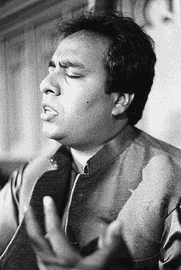
Review: Wasif Dagar's Two Tanpuras And A Microtone
North Indian classical singer brings Dhrupad style to U.S. for first time in 17 years
Review for www.sonicnet.com by Ira Landgarten:
NEW YORK - Dhrupad - North India's oldest form of classical vocal music, recently on the endangered species list - is alive and well.
Wednesday night in Greenwich Village's Washington Square Church, Ustad Faiyaz Wasifuddin Dagar enthralled an audience packed with some of the city's staunchest Indian music aficionados. Spotted in the audience were composer Philip Glass and colleague Jon Gibson.
Sponsored by the World Music Institute and the Aditi Foundation for the Arts, the performance marked the young master vocalist's U.S. debut, and was the first time in 17 years this rare musical form has been heard here.
Wasif continues the unbroken legacy of 20 generations of Dagar singers. Today the Dagars are virtually synonymous with Dhrupad.
It was fitting that the performance took place in a church, since Dhrupad is essentially devotional music. Like all Indian classical music, it is based on the melodic frameworks known as ragas. Dhrupad, however, evolved from the ancient Vedic tradition of chanting Hindu prayers, and Dhrupad singers seek to conjure in the listener an awareness of the One, the Divine.
Sitting cross-legged on a Persian carpet, eyes closed, in deep concentration, Wasif began the performance by first fine-tuning the pair of tanpuras (plucked drone instruments) that would provide the undulating, hypnotic sea of sound upon which his voice would sail. (They were played by his sister, Qamar, and Laurence Bastit, a French longtime supporter and student of the Dagars.) He then began the slow, deliberate nonrhythmic evocation of Raga Bihag, a prominent late-night melody saturated with romantic yearning.
With utmost subtlety and virtuosic vocal control, Wasif wove a spellbinding tapestry of sound. Gesturing expressively with his hands, he sent musical notes swooping, curving and cascading in a thrilling array of variations. He lovingly shaped not only each note, but also the microtonal sounds between them. "Feelings are very important," he told the audience at one point. "The words are feeble without feeling to empower them."
After nearly an hour of unraveling the raga's melody, Wasif began a 12-beat fixed composition accompanied by Mohan Shyam Sharma, playing the pakhawaj, a sonorous double-headed drum.
Particularly noteworthy was Wasif's use of "gamak," a trademark Dagar vocal technique with no parallel in Western music. His voice literally became a tuned rhythm instrument moving between notes with minute mechanical precision, as though it were driven by an internal piston. The audience swooned and sighed several times, thrilled by the unexpected turns and flights of Wasif's almost otherworldly delivery.
After an intermission, Wasif concluded the evening's program with a short, concise rendition of Raga Malkosh. Another late-night raga, it is a mainstay of the classical repertoire, with a somewhat serious, melancholy flavor. While enjoyable, it seemed more like a postscript to the Raga Bihag's slow, stately construction. (Review and Photos by Ira Landgarten)

Mohan Shyam Sharma, Qamar Dagar, Wasifuddin
Dagar, Laurence Bastit
Reviews
\\||// Wasifuddin Dagar